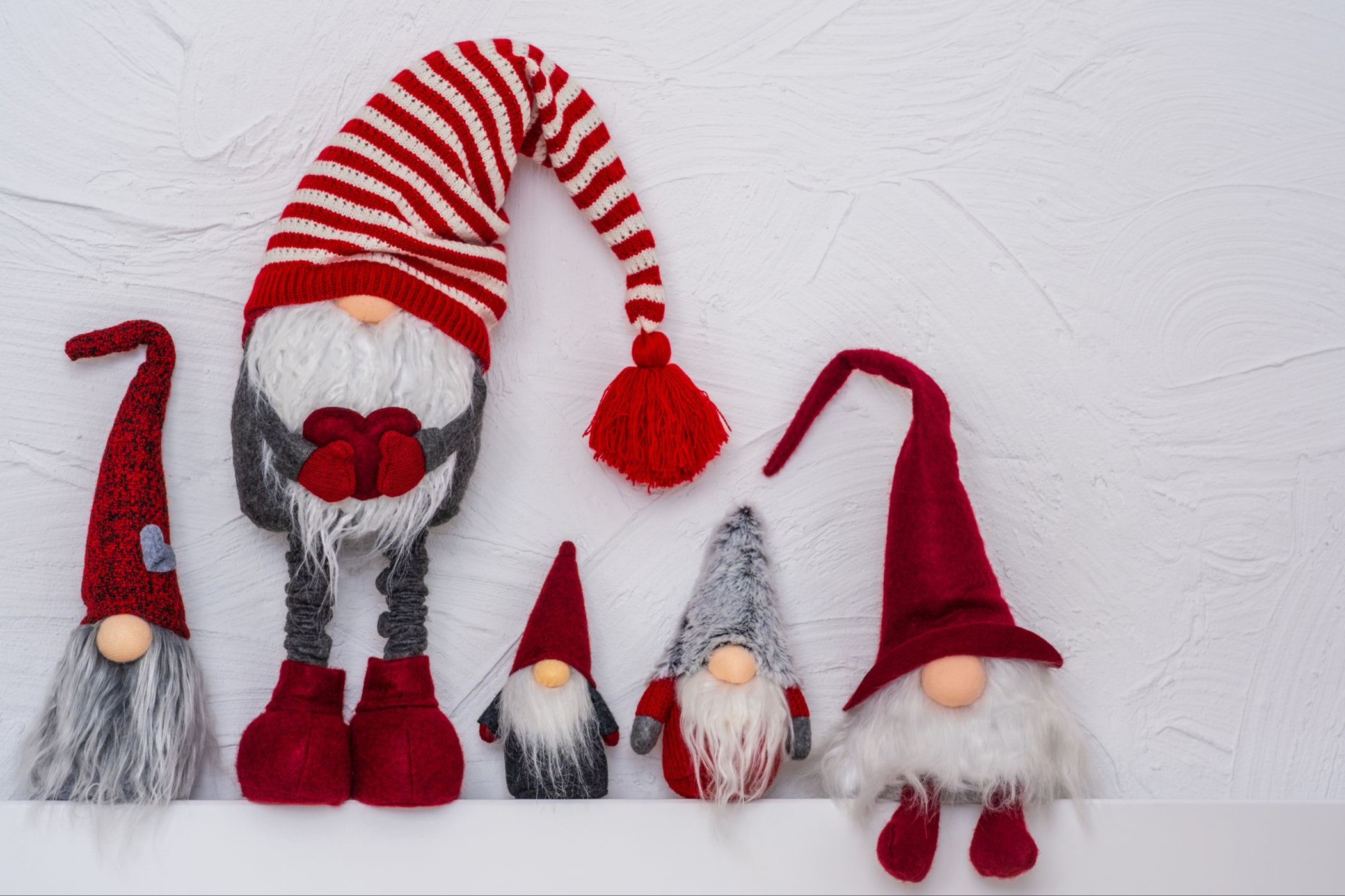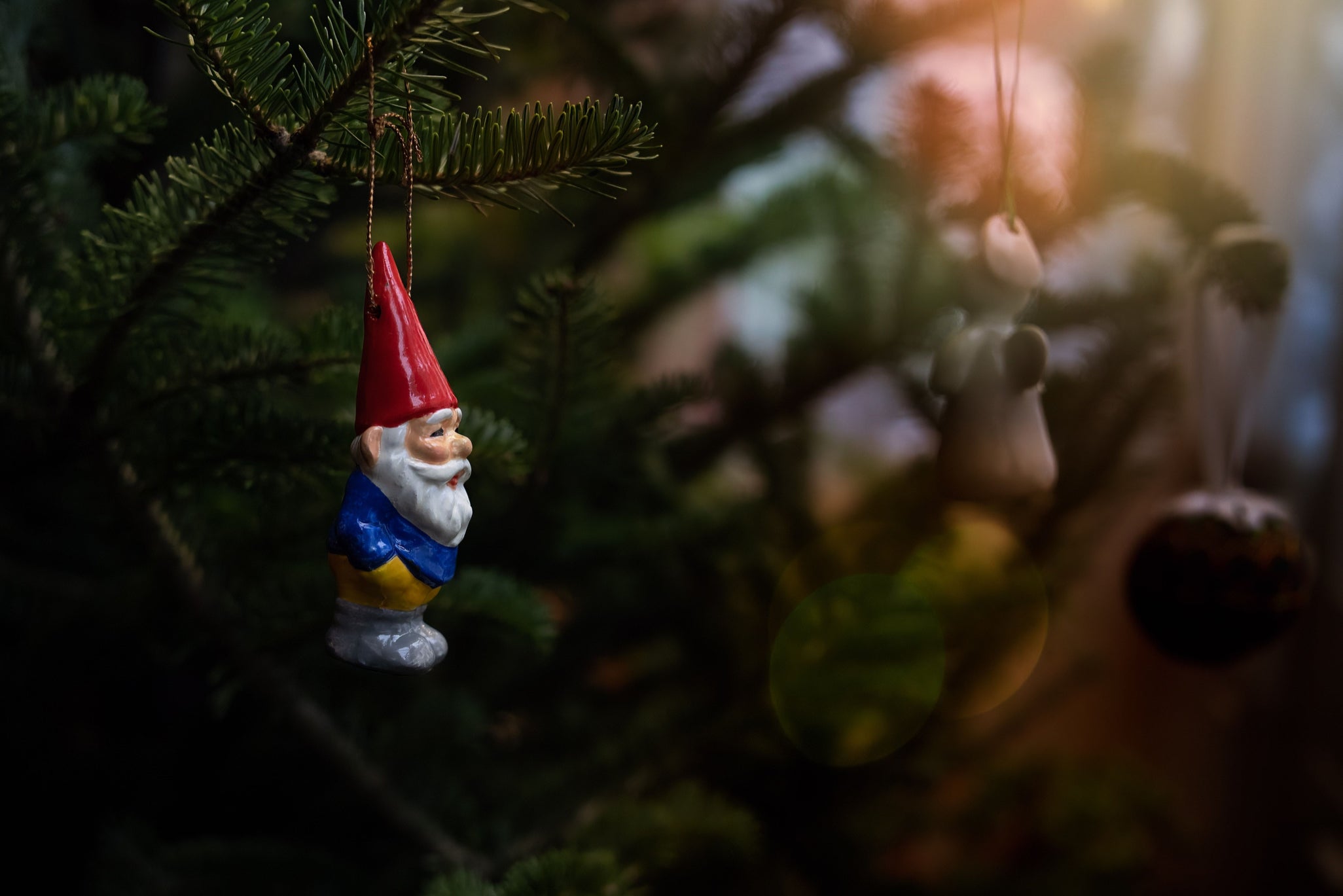
The takeover was both stealthy and speedy. Just a few short years ago, you could quite easily navigate the festive season without ever resting your eyes upon a gnome. Displays of Christmas decorations were populated instead with reindeer, snowmen and the odd spindly legged elf on the shelf. Gnomes, despite their luxuriant and Santa-esque facial hair, were not a part of the standard yuletide lineup; they were more commonly seen lurking on garden paths and clutching fishing lines by ponds all year round. And then, suddenly and seemingly out of nowhere, winter turned into gnome season.
Their bulbous noses, fluffy beards and pointy hats became ubiquitous, cropping up in supermarket aisles, on Instagram feeds and Pinterest boards, and on your next-door neighbours’ curated Christmas window sills. Now, they’re available in a vast array of materials and colour schemes. Shops such as Matalan and The Range are currently offering light-up neon outlines of gnomes, for a festive nod to the Love Island villa. Since Asda released a Christmas advert starring a gang of gnomes, searches for them on the supermarket’s website have shot up by 5,425 per cent. “Once people began listing the gnomes on sites like eBay, their desirability grew even further, with some fetching prices of over £40,” says Katie Chester, the brand’s chief gnome buyer.
If extraterrestrials came down to earth and landed in an out-of-town shopping centre during December, they might be forgiven for assuming that Christmas was a celebration of this all-powerful creature, rather than the birth of Jesus Christ. In fact, a cursory Google proves that you can, should you so wish, purchase Nativity scenes populated entirely by gnomes (the Virgin Mary gnome tends to be clean shaven, as does the baby Jesus). And yet, for all their omnipresence, these bearded characters are very much “a marmite Christmas decoration”, as Hannah Bartlett, a year-round Christmas writer, researcher and trend forecaster, puts it. For every person who waxes lyrical about the loveable whimsy of their growing collection, you’ll find someone who darkly describes them as “disturbing” or “creepy” (it’s something to do with the way their hats are pulled down over their eyes).
For many of us, though, the main emotion they evoke is a kind of bemused bafflement. Where did they come from? How did they so quickly establish supremacy over our Christmas decorations? In order to get to grips with this, a bit of disambiguation is required. “Gnome” is an umbrella term for a tiny humanoid creature, typically resembling a wizened old man decked out in a beard and some sort of pointy hat; they are rooted in German mythology, then became popularised when the Renaissance alchemist Paracelsus included them in a book about magical creatures.

On one branch of the gnome family tree, you will find the gonks, a name that is ridiculously satisfying to say, even if – or perhaps because – it sounds a bit like a playground insult. Gonks obscure their eyes (and indeed all their features, bar their prominent nose) with their hats; sometimes they don’t have a body, just a beard. In other words, they’re more stylised than your traditional gnome. They were originally known as “nisse” in Norwegian and Danish or “tomte” in Swedish, and can be traced back to Scandinavian and Nordic folklore. These little creatures would, according to legend, make themselves at home in houses or barns during the colder months. Families would leave bowls of porridge outside to appease them on winter solstice, because if humans treated them well, they would bring them good luck; if not, they would cause trouble (seems fair). But although gonks have been knocking around for centuries in Scandinavia, their UK invasion is more recent (confusingly, however, there was a craze for fluffy, big-eyed toys with the same name in Seventies Britain). We can chalk their rapid ascent up to two major factors: our embrace of all things Scandi, and the pandemic.
Towards the end of the 2010s, the UK seemed to become obsessed with living a more Nordic life; articles and books about embracing “hygge” – the Danish word for cosiness that no one over here could actually pronounce – were inescapable. No wonder, then, that we started looking to Scandinavia for decor inspiration. The rise of gnomes and gonks “aligns seamlessly with the global fascination with Scandinavian design principles and lifestyle philosophies”, says Riani Kenyon, behavioural analyst at consumer insights agency Canvas8. She notes that “their soft felt hats, fluffy beards and plump, handmade textures evoke a tactile DIY charm that aligns perfectly with the broader trend of ‘hygge’”.
They embody a love for fantasy and magic, especially in the darker season when people are looking for a little escapism
Christmas expert Bartlett pinpoints the winter of 2020 as the moment when these creatures really hit the mainstream in Britain. This was, of course, a time when many were stuck indoors thanks to the Covid lockdown, facing a festive season without friends and family. “During the pandemic, when we were feeling unsettled and spending time apart from loved ones, these cuddly little characters brought a much-needed dose of cheer,” she suggests. And without the usual whirl of parties and dinners, “people spent more time at home, focusing on creating warm, cosy spaces and enjoying crafts”, says Kenyon.
Since then, they’ve only become more popular. If they started out with a “simple, understated, glitter-free vibe”, as Bartlett puts it, they’ve become more extravagant year after year. And if you really want to pledge allegiance to the gnome overlords, you can buy patterned merch – cosy pyjamas! Slipper socks! – so you can wear your love on your sleeve (or feet).

More traditional-looking gnomes still get a look in, but gonks seem to be rapidly overtaking them. This might be down to their “incredibly distinctive silhouettes”, says Lana Zoppi, design director at Studio Noel. “This is always successful when it comes to characters,” she adds, as “the instantly recognisable shape means they stand out on a shelf”. Etsy’s trends expert Dayna Isom Johnson also notes that the craze for all things gnomic chimes with the rise of “mystical and medieval decor [and] folklore-inspired artwork” that she’s noticed across the marketplace this year. “They embody a love for fantasy and magic, especially in the darker season when people are looking for a little escapism,” she says.
And while yes, it’s possible to buy them in bulk from the retail park Big Three (I’m talking the holy trinity of Homesense, B&M and The Range here), crafting them by hand is still popular too. “One of my bestsellers is wool for gnome or gonk beards,” says Caroline Rimmer, founder of wool and craft suppliers Tregaver Fibre. “This time of year I sell out super quickly… Lots of people are moving towards natural fibres for their creations, especially those meaningful ones like Christmas ornaments that are passed onto the next generation.”
Handmade designs make for a more personal keepsake. Many of the gnome aficionados that I hear from explain that they first started collecting them for sentimental reasons, often because they’re a reminder of an older relative who loved buying or making them. Behavioural analyst Kenyon reckons that they embody a kind of “soft escapism”, an “aesthetic that values joy and sentimentality over grandeur or formality”. Despite my initial bemusement, I’ve rather come round to them. Which is probably for the best, because these gnomes aren’t going anywhere. Resistance is futile.







